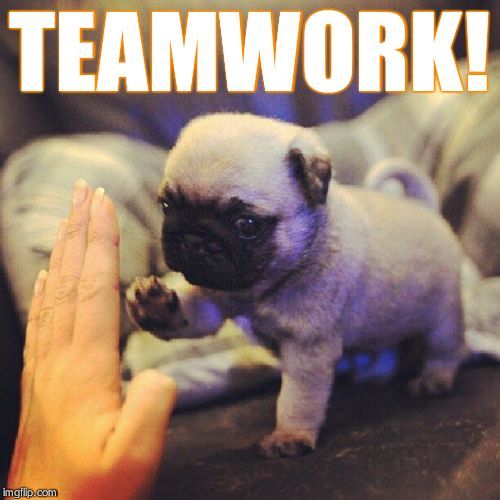“Talent wins games but team work and intelligence wins championships”
As youngsters, playing cricket and kabaddi is how we learn the word "Team" and it gains importance as we grow older. Can you imagine scoring a goal without the help of your team? Schools have sports teams, and various activities that all require the support and dedication of a team. From a very young age, we are taught the importance of a team, however are unable to use it in a workplace environment. Learning to work in teams and collaborate effectively is one of the easiest and most efficient ways to complete hard tasks and be more successful. A team player is someone who can work easily with others, and be open to other people’s opinions and ideas. Many individuals are against team work in the workplace, and employers should encourage as much collaboration as possible. The idea of a ‘team’ has changed drastically from what it was perceived before, becoming more diverse and efficient in today’s world.

In a team, every member has a role. The most prominent member of any team is the team leader. A leader must be able to lead his/her team towards achieving their goal. Workplace problems like biases, discrimination and harassment all constrict the sense of unity and enthusiasm of the troop. A great leader is not necessarily someone highly educated but he must display leadership abilities. The team should be willing to cooperate, assist and be led by him. A leader has to be trustworthy, reliable and competent; otherwise employees will never want to work with him. A vast majority of people want to follow someone they can relate to. There is no doubt that the success of a leader depends entirely on the way he or she motivates the subordinates. “Finding good players is easy. Getting them to play is another story’’, as only a competent leader can get talented individuals to work together. Poorly managed teams are on average 50% less productive and 44% less profitable than well managed teams, displaying the importance of leadership
It is observed that when one feels important and responsible for the fate of a task, that is when they put in their maximum efforts. This is exactly what a team does. It makes the employees or rather the members of a team feel empowered. It is done by charting out specific roles and tasks for the all group members. Efficient delegation is the key to this as that not only reduces workload but also ensures fulfillment of deadlines. This is imperative for cohesion of the members to one another as well as to the company goals at large which in turn paves way for success. “97% of employees and executives believe lack of alignment within a team impacts the outcome of a task or project.”
While working, it is not practically possible to be always surrounded by likeminded people. However the diversity of opinions and working styles can also lead to new ideas and discoveries. After all folks, let’s not forget that it takes five offbeat fingers to make a fist. There are people who perform well as individuals but fail miserably when they work in a team. They keep their cards close to their chest and don’t believe in sharing their ideas. This however is inefficient and does not translate to success; as an individual will have more difficulty in achieving what a team could easily do. “86% of employees and executives cite lack of collaboration or ineffective communication for workplace failures.”
Advantages of Working in a Team
- Increased Efficiency: When many people are working on the same project, it will take less time, improving efficiency. It will also make errors less possible, as many people will be monitoring the work.
- Ideas: When many people are working on the s
 ame project, there will be a greater inflow of ideas as compared to an individual working on it alone. Greater ideas and discussion will lead to the progress of the company
ame project, there will be a greater inflow of ideas as compared to an individual working on it alone. Greater ideas and discussion will lead to the progress of the company - Learning experience: Many individuals are unfamiliar with team-working scenarios. When employees in a firm start working in teams, they start learning team skills and develop their individual skills as well; proving to be learning experiences for the team.
- Greater communication: When individuals start working together, they will have great communication with each other; enhancing the workplace. Businesses with effective communication are 50% more likely to have lower employee turnover.
- Distribution of workload: It’s obvious that when a lot of hands are working towards the same goal, there will be less time involved.
- Motivates individuals: People working together will motivate each other to work harder, and encourage team members. This uplifts the team morale. 67% employees believe colleagues can encourage them to do their jobs better.
- Support network: Once employees start working together, they will become familiar with each other, using each other as a support network. This can work to reduce stress and pressure in the workplace and lead to better employee engagement.
It is when the employees lose their driving force, that they lose interest in their work and get distracted. It is then that it becomes all the more necessary for the team to bring back their lost gimmick. In other words, when one member falls down, the fellow comrades lift him/her back. The team spirit keeps them all motivated and fuels their efforts.
What Keeps a Team Motivated?
What Keeps a Team Motivated?
- Direction: Teams need a unified goal to work towards. When teams are clear and specific about what they want to achieve, they will work sole-mindedly on it. The goals shouldn’t be too far-fetched, as this will demotivate the team. It is especially crucial for virtual team-work as everyone needs to have a united idea of the team’s purpose.
- Structure: Teams need to have a defined structure; knowing who to turn for what. A clear leaderneeds to be defined for overseeing the work, someone else for delegating the tasks etc. The team needs to consist of people with different skills, balancing the work-load.
- Context: An efficient team needs to have a good support system. This also includes maintaining a reward system to complement some outstanding individuals in the team. Maintaining the resources for the team is also another component of retaining context for teamwork.
Mother Teresa once said “You can do what I cannot do. I can do what you cannot do. Together we can do great things.” This is a major ingredient in the recipe of any successful venture. We must never forget that Trust and Respect are two pillars which help to sustain a blooming team. Forming teams in a firm can help improve efficiency and employee engagements. Employers need to understand that only when employees start working together, they will be better motivated and have the ability to reach to their greater potential. After all, Team work - makes the dream work!
Posted in : Work Culture
Views : 36845
Leave a Comment
Hey there !
Author Details
Related Blogs
Popular Tags
Subscribe Now








